Albert Park, Motorsport & Politics: A 90-Year Battle

While the Formula One circus rolls into town for next weekend’s Australian Grand Prix, the 26th modern running of the event continues Albert Park’s rich circuit racing heritage, which dates back to the 1950s. However, its roots extend beyond that, with plans hatched in the 1930s to convert the lakeside setting into a downtown street circuit. This is the story of how car racing’s first attempt to take over the park 90 years ago crashed and burned in a political storm.
Between 1953 and ’58, a total of six events were contested alongside the artificial lip of the Albert Park Lake, with the significant meets including a pair of Australian Grands Prix.
We covered these events in our 70 years of the Albert Park Circuit feature.
In the 1950s, motorsport was difficult to access, with the sport utilising far-flung ex-military airfields converted for competition purposes, but back before the war, racetracks were scarce.
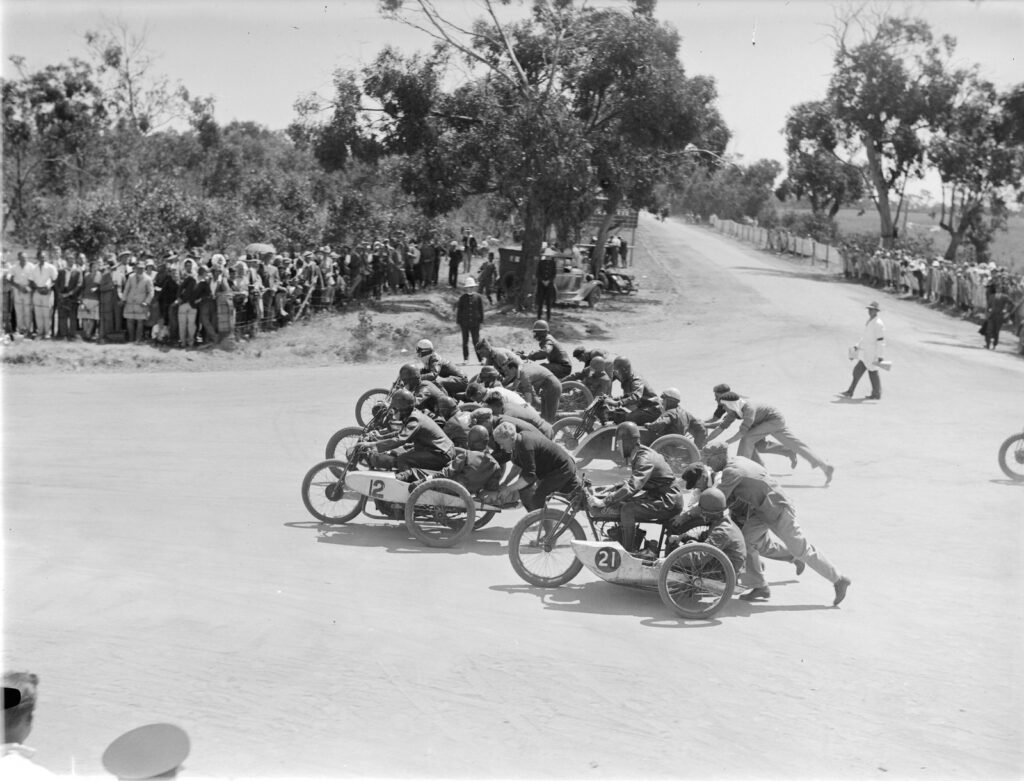
Yes, the Phillip Island Road Circuit, above, from the State Library of Victoria archive, was in operation since 1928, with its dusty dirt track a cut lunch across a rickety bridge from Melbourne, but it was far from an ideal outlet to grow the sport.
Closer to the heart of town, Albert Park was a perfect solution.
And frankly, the endearing qualities of Albert Park in the 1930s compared to modern times are identical – it’s easy to access, especially with a plethora of public transport options, there is plenty of space to house a big crowd, plus the racetrack can be contained within one rather massive city block, without disturbing any of the nearby main thoroughfares.
However, like the more modern-day Save Albert Park movement, in the 1930s, NIMBYs, local hospitals and political players were loud in their disapproval of the reserve being closed for public access and taken over by competition motors.
This story follows the first attempt at bringing motorsport to the masses around the outside of the Albert Park Lake, as it played out in the Melbourne press of the day.
Centenary Celebrations – Organiser Assumes Duties
Friday, May 19, 1933 – The Argus
The first mention of plans for the car meet at Albert Park appears to date back to 1933, when Brigadier-General C.H. Jess, who was charged as the organiser of Victoria’s 1934 centenary celebrations, met with officials from the Light Car Club of Australia (LCCA).
Of note, the LCCA was the driving force behind the original Phillip Island Circuit, the later successful first round of racing at Albert Park, and ultimately Sandown Raceway, amongst a wide range of motorsport activities.
International Motor Race
Tuesday, July 11, 1933 – The Age
Representatives of the LCCA, members of the management committee of Albert Park and the Commissioner of Police, T.A. Blamey, visited Albert Park to start planning for the Centenary Race.
It was noted in The Argus on the same day that silencers had been tested out on race cars successfully, while grandstands would be erected around the course and at the finishing line.
Car Race in Albert Park
Thursday, July 13, 1933 – The Age
Cr Parry, at the meeting of the South Melbourne council, noted that the Albert Park Committee would insist that cars be silenced to enable them to compete.
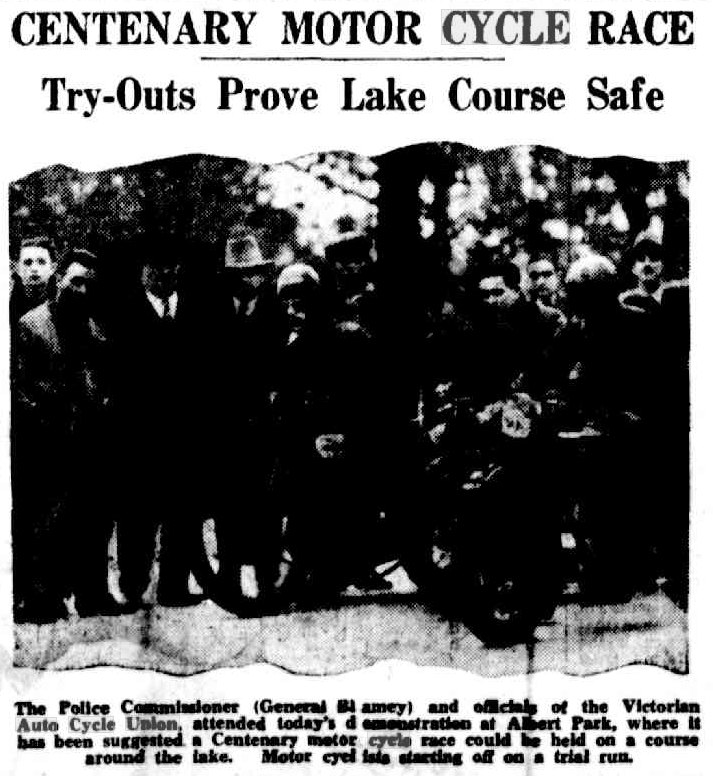
Centenary Races – Motor Cycle Events in Melbourne
Thursday, August 10, 1933
Parallel to the moves by the four-wheel set, the Auto-Cycle Union of Victoria put the cogs in motion for its own centenary motorcycle event at Albert Park, which ultimately had hoped to be the Australian Tourist Trophy, a meet of higher stature than the AGP, set for October 1934.
The above image from the following day in The Herald depicted motorcyclists testing out the concrete course, with a meeting following the trial seeing the trustees of the park approve the concept.
Ultimately, the plans were shelved in April 1934 when it was considered too big a task to safely police spectators around the course, with the lack of a suitable date later also cited as a stumbling block.
Long Distance Car Racing – Albert Park Plan
Wednesday, April 18, 1934 – The Herald
It was noted that a crowd of 100,000 people would attend the prospective event, with negotiations ongoing for the closure of the park, the right to let concession booths be placed on site, plus the ability to charge parking fees.
The Albert Park committee of management is noted to have no objection to the race, “provided it is not held on a Saturday,” and interfere with the many recreational sport users of the venue.
On the 21st of April, the Record noted that “Theer (sic) was every probability that, if the race were permitted, Sir Malcolm Campbell would gve (sic) an exhibition with his weird car.”

The proposed 1934 layout in a word: fast.
Centenary Race – 250 Miles on Albert Park Track – Big Event on November 7
Monday, June 4, 1934 – The Herald
It was officially announced today that arrangements had been completed for a 250-mile motor race round the Albert Park Reserve during the Centenary Celebrations.
The joint committee of the Light Car Club of Victoria and the Royal Automobile Club of Victoria was formed some months ago (late July 1933) to organise a race for light cars, as it was felt that such an event during the Centenary would not only provide an attraction for Australian motorists, but also for overseas visitors.
All sections of the community, particularly those connected with the motor trade, have shown a keen desire that such a race should be staged, and it is now announced by officials of the combined committees that all preliminary difficulties have been overcome and the event will be held on November 7 (the day after the Melbourne Cup). This date has been approved by the Centenary Council, which will grant the race its official patronage.
It has not been finally decided over what distance the race will be held, although the committee is in favour of a limit of 250 miles, thus enabling the event to be completed during the afternoon.
Grand Prix Conditions
In view of the nature of the track around the Albert Park Lake, cars eligible to enter will be restricted to those having an engine capacity of not more than 2500cc. The race will be run on a handicap basis, and the general conduct thereof will be similar to that adopted by the Light Car Club at the annual Grand Prix at Cowes.
This will be the biggest motor racing event promoted in Australia. It will bring Australian motor racing more in line with events in Europe, and will closely resemble the famous Phoenix Park race in Dublin, over a circuit of approximately the same length.
Experienced drivers have tested the Albert Park track at speed, and found it eminently suitable for racing purposes. A large and representative field is expected to face the starter, and the public will have the opportunity of viewing a most exciting race between the latest types of racing cars under ideal conditions.
Work will shortly commence on the track, as it is not intended to make use of any portion of Queens Road, and when completed, the circuit will be approximately 3¾ miles (6km) in length.
Should the entries exceed the number which may be accommodated safely on the track, a smaller race for cars of limited capacity may be held during the morning.
Intending competitors should direct their inquiries to the secretary of either the Light Car Club or Royal Automobile Club.
The amount of prize money to be distributed is at present uncertain, but a considerable sum is likely to be available.
The following day, The Herald continued its coverage with the above track map, noting that the police and the Albert Park Trustees had approved the concept.
One alteration to the then current road network was required, however, with a short 200-yard length of road to be built behind the new high school on the corner of Queens and Albert Roads, enabling Queens Road to be kept open during the meet.
It was noted that existing fences would be used, with special barricades (read: sandbags) utilised in danger points, with the pits to be established near The Chalet tennis courts, not far from the modern-day pitlane.
The layout was considered safe compared to other European street tracks, and “there will be no corner dangers such as (those that) exist in the annual Monaco road race.”
Speeds were expected to average between 75 and 80 miles per hour (120-130km/h).

The above image of the southern end of the Albert Park Lake from the 1950s shows the alternate concrete road that was proposed for the Centenary Race – as seen on the left-hand side of the picture, running through what is now the Golf Course. Remanents of that road still remain to this day. The 1950s track and the modern iteration use the road adjacent to the lake, although running in opposing directions. Pic: State Library of Victoria
Albert Park Race – Hospitals to Protest
Wednesday, June 6, 1934 – The Herald
Two of the four private hospitals in Queens Road, Albert Park, will protest to the Albert Park Committee against the 250 mile Centenary Car Race in the Park.
Matrons of the hospitals said that the noise of the cars would cause serious inconvenience, and perhaps danger to patients. Motor boat racing on the lake caused a terrific noise, and with great difficulty, they obtained a promise that no further racing would be permitted in the park.
“Silence Guaranteed”
Officials of the races said today that the race committee had guaranteed that cars would be so silenced that no discomfort would be caused to the hospital patients or others.
The Chief Commissioner of Police (General Blamey) had inspected the track while three cars with proper silencers raced at full speed. He had agreed that even a large field of cars would not be unduly noisy if they were efficiently silenced.
On the same day, the newspaper ran an editorial questioning the race.
The promoters might reasonably be asked for an assurance that this track will be used for the Centenary occasion only. Experience has taught the Victorian community that once a concession in a public park has been obtained it is often extended but seldom relinquished. If the existing road round the park is to be utilised its use will be denied to its owners, the people, for at least some months while it is being prepared and for the period of the celebrations. If a new track is cut, it will be a flagrant alienation.
Letters to the Editor
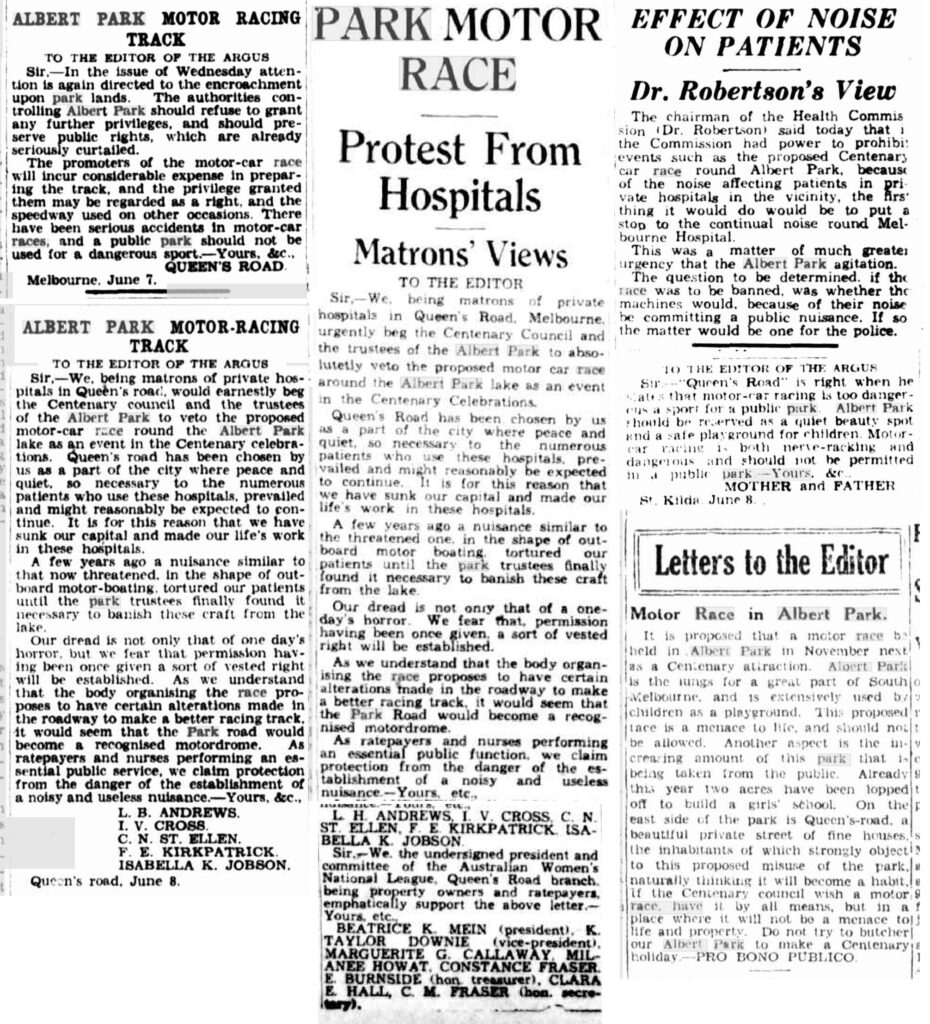

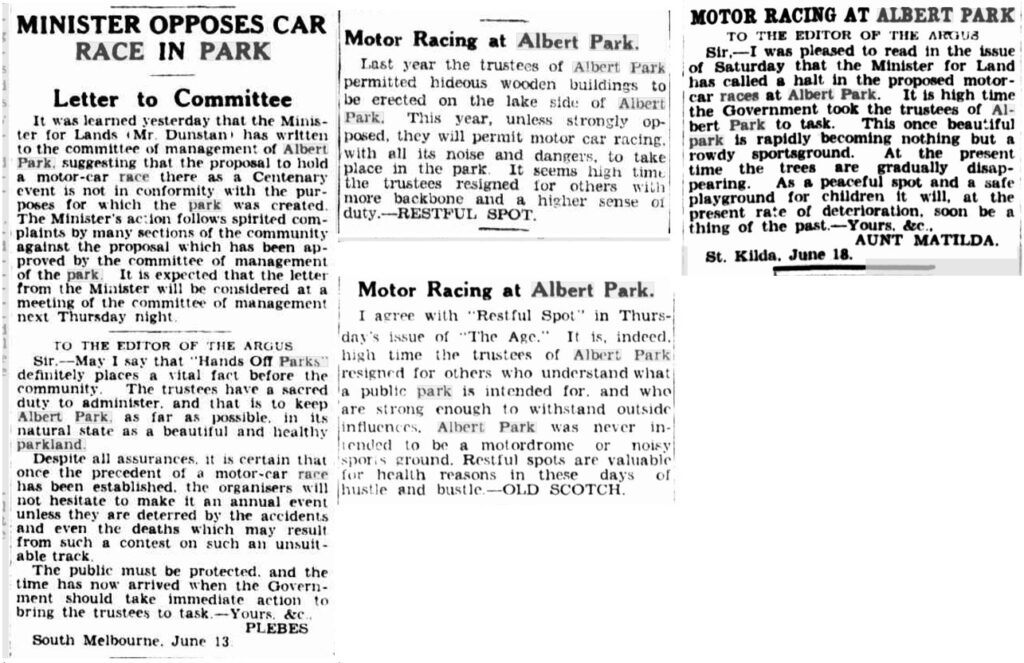
The Argus, Friday, June 8, 1934, Saturday, June 9, 1934, Tuesday, June 12, 1934,Wednesday, June 13, 1934, Thursday, June 14, 1934, Saturday, June 16, 1934, Tuesday, June 19, 1934
The Herald, Saturday, June 9, 1934, Monday, June 11, 1934, Tuesday, June 12, 1934
The Age, Tuesday, June 12, 1934, Thursday, June 14, 1934, Saturday, June 16, 1934
Notably, people hiding behind a pseudonym wasn’t invented when social media became a thing…
Motor Racing in Albert Park – St Kilda Councillor’s Protest
Wednesday, June 13th, 1934
The issue of the racetrack blew up at a St Kilda Council meeting.
Councillor Taylor said he would be sorry to see Albert Park brought to the state of Phillip Island when motor racing was held. “On such occasions, it was a miniature hell on earth – motor racing was not wanted in Albert Park.”
Completing Details for Albert Park Car Race
Tuesday, June 19th, 1934 – The Herald
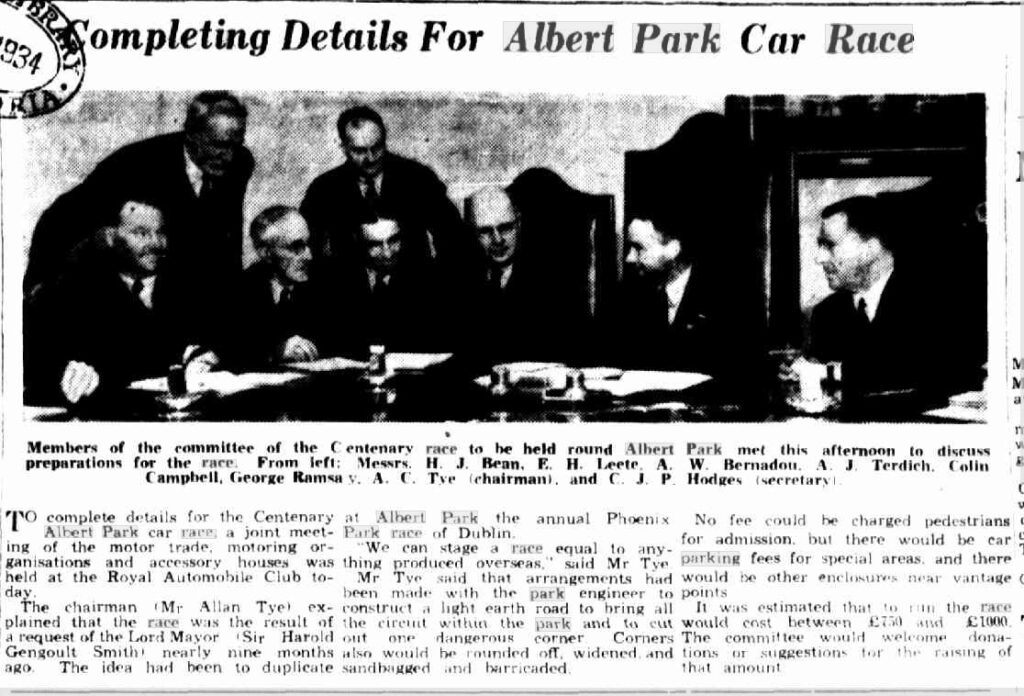
Albert Park Motor Race – Grievance of Motor Trade
Wednesday, June 20, 1934 – The Age
A combined LCCA and RACV meeting blew up when Mr L.H. Caldwell, representing the Australian Association of British Manufacturers, demanded that all sections of the motor and allied trades be given equal representation on the central organising committee for the event.
The meeting was subsequently adjourned, although it was earlier noted that £750-1000 would be required to finance the construction of the track, with any surplus from the event to be split between the Albert Park Trust and the local hospitals.
Last Minute News – Car Race in Park – Minister Doubts Legality
Thursday, June 21, 1934 – The Herald
Mr Dunstan, the Minister for Lands wrote to the Albert Park committee noting that the “motor car race was not in accordance with the purposes for which the park was established.”
A week later, The Herald noted that the event was approved by The Centenary Council, The Albert Park Committee of Management and the Chief Commissioner of Police, with Mr Dunstan using his position to have a final veto over the event.
Car Race at Albert Park – Ministerial Opposition – Mr Dunstan Outspoken – “All Motor-racing Dangerous”
Friday, June 29, 1934 – The Argus
Mr Dunstan: Any form of motor-racing is dangerous to the public. Cars may get out of order, crash through the barriers, and may kill several persons. The area was not reserved for a purpose like this. I always find, too, that noise is associated with motor-racing of any kind.
Mr Williams (Chairman of the Committee of Management of Albert Park): Eight cars went round the track without the noise being noticed by hospital authorities in the neighbourhood.
Mr Dunstan: I am opposed altogether to the proposal which would establish a precedent. I do not wish to mince matters. I think it would be wrong to have this race at Albert Park. More suitable sites could be found.
…
Mr Dunstan said that the committee of management controlled the park, but now that it was acquainted with his views it would, no doubt, be able to cope with the position.
It seems that political threats were not veiled in the 1930s…
Car Race at Albert Park – Objection Raised at Council Meeting – “Plenty of press propaganda, Council knows nothing!”
Saturday, June 30, 1934 – Record
At a South Melbourne Council meeting, it was raised that they had received very little information on the planned race meet, outside of what had been circulated in the press.
Motor-Races Near City – No Suitable Track – Objections to Albert Park
Tuesday, July 3, 1934 – The Argus
The motoring column examined the situation for motorsport locally, with the most likely successful outcome being a facility built on private property.
The article looked at successful venues from overseas, with examples including Brooklands, Montlhéry, Avus, the Nurburgring, Monza, Littario and Indianapolis.
No Motor-racing at Albert Park – Alpine Trial Instead
Wednesday, July 11, 1934 – The Argus
The Centenary motor race proposed by the Light Car Club of Australia on a course round the Albert Park Lake will not be held. In its place, the club has decided to conduct a dependability test through the alpine districts of Victoria to extend over four days from Saturday November 3.
Because of the opposition to the race at Albert Park, the club has been searching for another suitable track in a central situation, but without success.
Mr Tye (LCCA President) said that the Minister for Lands (Mr Dunstan), replying to the club’s application for permission to use the Albert Park circuit for racing, had said that it was intended to complete the improvements now in progress at Albert Park, including a road making programme. The road therefore would not be available for racing.
The Age on the same day noted that concreting of the roads would extend past the end of the year, and be complemented by the planting of more than 2,000 trees.
Ultimately, further plays would be made by both two-and-four-wheel interests into the future, especially in 1937, when a concerted push was made to schedule a combined meet in aid of the Lord Mayor’s Fund charity.
However, motorsport had to wait until the 1950s, and then again in 1996, to visit Albert Park.
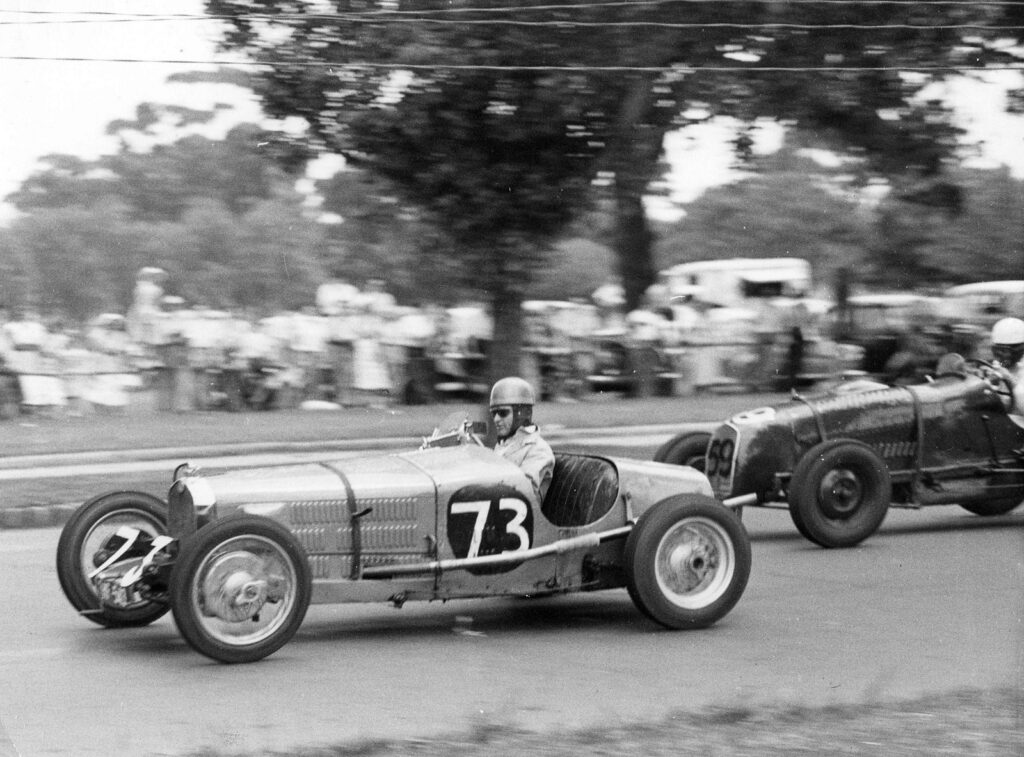
Jack Lanham behind the wheel of a Lombard at Albert Park in 1953. Pic: State Library of Victoria







